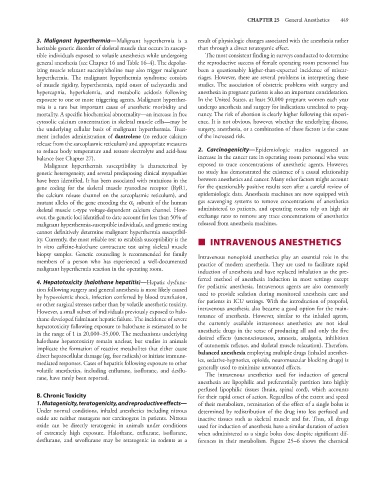Page 463 - Basic _ Clinical Pharmacology ( PDFDrive )
P. 463
CHAPTER 25 General Anesthetics 449
3. Malignant hyperthermia—Malignant hyperthermia is a result of physiologic changes associated with the anesthesia rather
heritable genetic disorder of skeletal muscle that occurs in suscep- than through a direct teratogenic effect.
tible individuals exposed to volatile anesthetics while undergoing The most consistent finding in surveys conducted to determine
general anesthesia (see Chapter 16 and Table 16–4). The depolar- the reproductive success of female operating room personnel has
izing muscle relaxant succinylcholine may also trigger malignant been a questionably higher-than-expected incidence of miscar-
hyperthermia. The malignant hyperthermia syndrome consists riages. However, there are several problems in interpreting these
of muscle rigidity, hyperthermia, rapid onset of tachycardia and studies. The association of obstetric problems with surgery and
hypercapnia, hyperkalemia, and metabolic acidosis following anesthesia in pregnant patients is also an important consideration.
exposure to one or more triggering agents. Malignant hyperther- In the United States, at least 50,000 pregnant women each year
mia is a rare but important cause of anesthetic morbidity and undergo anesthesia and surgery for indications unrelated to preg-
mortality. A specific biochemical abnormality—an increase in free nancy. The risk of abortion is clearly higher following this experi-
cytosolic calcium concentration in skeletal muscle cells—may be ence. It is not obvious, however, whether the underlying disease,
the underlying cellular basis of malignant hyperthermia. Treat- surgery, anesthesia, or a combination of these factors is the cause
ment includes administration of dantrolene (to reduce calcium of the increased risk.
release from the sarcoplasmic reticulum) and appropriate measures
to reduce body temperature and restore electrolyte and acid-base 2. Carcinogenicity—Epidemiologic studies suggested an
balance (see Chapter 27). increase in the cancer rate in operating room personnel who were
Malignant hyperthermia susceptibility is characterized by exposed to trace concentrations of anesthetic agents. However,
genetic heterogeneity, and several predisposing clinical myopathies no study has demonstrated the existence of a causal relationship
have been identified. It has been associated with mutations in the between anesthetics and cancer. Many other factors might account
gene coding for the skeletal muscle ryanodine receptor (RyR1, for the questionably positive results seen after a careful review of
the calcium release channel on the sarcoplasmic reticulum), and epidemiologic data. Anesthesia machines are now equipped with
mutant alleles of the gene encoding the α subunit of the human gas scavenging systems to remove concentrations of anesthetics
1
skeletal muscle l-type voltage-dependent calcium channel. How- administered to patients, and operating rooms rely on high air
ever, the genetic loci identified to date account for less than 50% of exchange rates to remove any trace concentrations of anesthetics
malignant hyperthermia-susceptible individuals, and genetic testing released from anesthesia machines.
cannot definitively determine malignant hyperthermia susceptibil-
ity. Currently, the most reliable test to establish susceptibility is the ■ INTRAVENOUS ANESTHETICS
in vitro caffeine-halothane contracture test using skeletal muscle
biopsy samples. Genetic counseling is recommended for family Intravenous nonopioid anesthetics play an essential role in the
members of a person who has experienced a well-documented practice of modern anesthesia. They are used to facilitate rapid
malignant hyperthermia reaction in the operating room. induction of anesthesia and have replaced inhalation as the pre-
ferred method of anesthesia induction in most settings except
4. Hepatotoxicity (halothane hepatitis)—Hepatic dysfunc- for pediatric anesthesia. Intravenous agents are also commonly
tion following surgery and general anesthesia is most likely caused used to provide sedation during monitored anesthesia care and
by hypovolemic shock, infection conferred by blood transfusion, for patients in ICU settings. With the introduction of propofol,
or other surgical stresses rather than by volatile anesthetic toxicity. intravenous anesthesia also became a good option for the main-
However, a small subset of individuals previously exposed to halo- tenance of anesthesia. However, similar to the inhaled agents,
thane developed fulminant hepatic failure. The incidence of severe the currently available intravenous anesthetics are not ideal
hepatotoxicity following exposure to halothane is estimated to be anesthetic drugs in the sense of producing all and only the five
in the range of 1 in 20,000–35,000. The mechanisms underlying desired effects (unconsciousness, amnesia, analgesia, inhibition
halothane hepatotoxicity remain unclear, but studies in animals of autonomic reflexes, and skeletal muscle relaxation). Therefore,
implicate the formation of reactive metabolites that either cause balanced anesthesia employing multiple drugs (inhaled anesthet-
direct hepatocellular damage (eg, free radicals) or initiate immune- ics, sedative-hypnotics, opioids, neuromuscular blocking drugs) is
mediated responses. Cases of hepatitis following exposure to other generally used to minimize unwanted effects.
volatile anesthetics, including enflurane, isoflurane, and desflu- The intravenous anesthetics used for induction of general
rane, have rarely been reported.
anesthesia are lipophilic and preferentially partition into highly
perfused lipophilic tissues (brain, spinal cord), which accounts
B. Chronic Toxicity for their rapid onset of action. Regardless of the extent and speed
1. Mutagenicity, teratogenicity, and reproductive effects— of their metabolism, termination of the effect of a single bolus is
Under normal conditions, inhaled anesthetics including nitrous determined by redistribution of the drug into less perfused and
oxide are neither mutagens nor carcinogens in patients. Nitrous inactive tissues such as skeletal muscle and fat. Thus, all drugs
oxide can be directly teratogenic in animals under conditions used for induction of anesthesia have a similar duration of action
of extremely high exposure. Halothane, enflurane, isoflurane, when administered as a single bolus dose despite significant dif-
desflurane, and sevoflurane may be teratogenic in rodents as a ferences in their metabolism. Figure 25–6 shows the chemical

